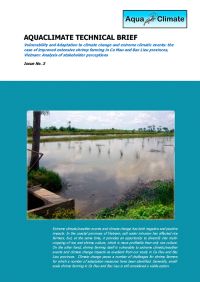This document is Version 3.0 of “Better Management Practices for Catfish Aquaculture in the Mekong Delta, Vietnam”. It incorporates revisions of previous versions and experiences from demonstration farms, as well as feedback from a National CatFish BMP Workshop, held 23-24 November 2010 in Long Xuyen City, An Giang Province, involving all stakeholders of the tra/striped catfish (Pangasianodon hypophthalmus) farming sector of the Lower Mekong Delta. A Vietnamese translation is available.
In Vietnam, small scale farmers and other stakeholders involved in aquaculture perceive that climate changes such as frequent extreme weather events have serious impacts on their farming systems. Farmers have started to adapt by changing the management practices. Institutional initiatives that have been introduced includes provision of budget for climate change response for aquaculture, aquaculture area planning and monitoring, government financial support, policy on mangrove planting for coastal protection and development of farmer associations.
This regional review study is an effort to promote improved inland fisheries management under the Code of Conduct for Responsible Fisheries. It covers ten Asian countries with significant inland capture fisheries, namely Bangladesh, China, India, Indonesia, the Republic of Korea, Myanmar, Nepal, Sri Lanka, Thailand and Viet Nam. The papers were presented and discussed at a regional workshop held from 8-11 February 2010 in Pattaya, Thailand. Audio recordings of the presentations are also available for download.
The conference was organised by FAO, the Thai Department of Fisheries and NACA and held in the Mövenpick Resort and Spa, Phuket, Thailand, 22-25 September. The conference was the third in a series of aquaculture development conferences, following on from the Conference on Aquaculture in the Third Millennium held in Bangkok 2000, and the FAO Technical Conference on Aquaculture, held in Kyoto 1976.



